Urine Blockage in Newborns
On this page:
The urinary tract consists of
- two kidneys, which filter waste materials and excess water from the blood
- two ureters, which carry urine from the kidneys to the bladder
- the bladder, where urine is stored until it is released
- the urethra, where urine flows out of the body
We rely on our kidneys and urinary system to keep fluids and natural chemicals in our bodies balanced. While a baby is developing in the mother’s womb, much of that balancing is handled by the mother’s placenta. The baby’s kidneys begin to produce urine at about 10 to 12 weeks after conception, but the mother’s placenta continues to do most of the work until the last few weeks of the pregnancy. Wastes and excess fluid are removed from the baby’s body through the umbilical cord. The baby’s urine is released into the amniotic sac and becomes part of the amniotic fluid. This fluid plays a role in the baby’s lung development.
Sometimes, a birth defect in the urinary tract will block the flow of urine in an unborn baby. As a result, urine backs up and causes the ureters and kidneys to swell. Swelling in the kidneys is called hydronephrosis. Swelling in the ureters is called hydroureter.
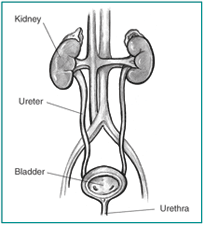
Normal urinary tract.
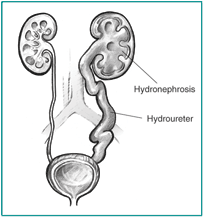
Swelling in the kidney is called hydronephrosis. Swelling in the ureter is called hydroureter.
Hydronephrosis is the most common problem found during ultrasound examination of babies in the womb. The swelling may be barely detectable or very noticeable. The results of hydronephrosis may be mild or severe, but the long-term outcome for the child’s health cannot always be judged by the severity of swelling. Urine blockage may damage the developing kidneys and reduce their ability to filter. The blockage may also raise the risk that the child will develop a urinary tract infection (UTI). Recurring UTIs can lead to more permanent kidney damage. In the most severe cases of urine blockage, the amniotic sac is so reduced that the lack of fluid threatens the baby’s lung development.
[Top]
Types of Defects in the Urinary Tract
Hydronephrosis can result from many types of defects in the urinary tract. Doctors use specific terms to describe the type and location of the blockage.
Vesicoureteral reflux (VUR). The openings where the ureters empty urine into the bladder should work like valves to keep urine from backing up into the ureters. Sometimes the valve doesn’t work properly and urine flows back into the kidneys. The urine may flow only a short way back into the ureters, or it may go all the way back to the kidneys, causing the ureters and kidneys to swell. VUR may occur in only one ureter or in both. Kidneys with severe reflux may not develop normally, and after birth kidneys with reflux may be at risk for damage from infections. Ureteropelvic junction (UPJ) obstruction. The point where the ureter joins the kidney is called the ureteropelvic junction. If urine is blocked here, only the kidney swells. The ureter remains at a normal size. UPJ obstruction usually only occurs in one kidney. Bladder outlet obstruction (BOO). BOO describes any blockage in the urethra or at the opening of the bladder. The obstruction may occur in boys or girls. The most common form of BOO seen in newborns and during prenatal ultrasound examinations is posterior urethral valves (PUV). BOO caused by PUV occurs only in boys. Posterior urethral valves (PUV). In boys, sometimes an abnormal fold of tissue in the urethra keeps urine from flowing freely out of the bladder. This defect may cause swelling in the entire urinary tract, including the urethra, bladder, ureters, and kidneys. Ureterocele. If the end of the ureter does not develop normally, it can bulge, creating what is called a ureterocele. The ureterocele may obstruct part of the kidney or the bladder.
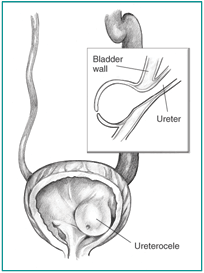
Ureterocele. The inset shows a cross-section of the ureter bulging into the interior of the bladder.
Nerve dsease. Urination requires coordinated nerve signals between the bladder, spinal cord, and brain. Spina bifida and other birth defects that affect the spinal cord may interrupt nerve signals and lead to urine retention in newborns.
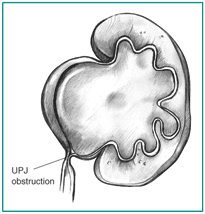
Ureteropelvic junction (UPJ) is the point where the ureter joins the kidney.
[Top]
Syndromes That May Affect the Urinary Tract
In addition to defects that occur in a single spot in the urinary tract, some babies are born with genetic conditions that affect several different systems in the body. A condition that includes multiple, seemingly unrelated problems, is called a syndrome.
- Prune belly syndrome (PBS). Occurring only in boys, PBS causes a baby to have an enlarged abdomen because the normal abdominal wall muscles are missing or very weak. The entire urinary tract is enlarged, and both testicles remain inside the body instead of descending into the scrotum. The skin over the abdomen is wrinkled, giving the appearance of a prune. Most children with PBS have hydronephrosis and VUR.
- Esophageal atresia (EA). EA is a birth defect in which the esophagus is incomplete. The esophagus is the tube that carries food from the mouth to the stomach. About 30 percent of babies born with EA will have problems in other body systems, such as the heart or urinary tract.
- Congenital heart defects. Heart defects range from mild to life threatening. Children born with heart defects also have a higher rate of problems in the urinary tract than children in the general population, suggesting that some types of heart and urinary defects may have a common genetic cause.
[Top]
Diagnosis
Birth defects and other problems of the urinary tract may be discovered before the baby is born, at the time of birth, or later, when the child is brought to the doctor for a urinary tract infection or urination problem.
Prenatal Screening
Tests during pregnancy can help determine if the baby is developing normally in the womb.
- Ultrasound. Ultrasound uses sound waves to produce a picture on a television screen. A wand gliding on the mother’s abdomen directs harmless sound waves into the womb. The sound waves bounce off the baby and back into the wand to create a black-and-white image on the screen. Ultrasound images can even display internal organs within the baby, so enlarged kidneys, ureters, or bladder may be visible.
- Amniocentesis. In amniocentesis, the doctor inserts a needle through the mother’s skin into the amniotic sac to collect about an ounce of amniotic fluid. The fluid contains genetic material from the baby that can be analyzed for signs of defects.
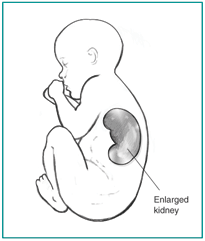
Ultrasound allows evaluation of a baby’s internal organs, even before birth.
- Chorionic villus sampling (CVS). In CVS, the doctor collects a small piece of tissue from the placenta using a needle passed through the mother’s vagina and cervix. The placenta has the same genetic makeup as the baby.
Most healthy women do not need all the tests. Ultrasound examinations during pregnancy are routine, although they are not always required and rarely influence treatment decisions. Amniocentesis and CVS are recommended only when a risk of genetic problems exists because of family history or something detected during an ultrasound. Amniocentesis and CVS carry a slight risk of harming the baby and mother, or ending the pregnancy in miscarriage, so those risks should be weighed carefully against the potential benefits of learning about the baby’s condition.
Examination of Newborn
Sometimes a newborn does not urinate as expected, even though prenatal testing showed no sign of urine blockage. The baby may urinate only small amounts or not at all. An enlarged kidney may be felt during the newborn examination as well. Different imaging techniques are available to determine the cause of the problem.
- Ultrasound. Once the baby is born, ultrasound can be used to view the baby’s urinary tract directly for a clearer image than could be achieved while the baby was in the womb.
- Voiding cystourethrogram (VCUG). If the doctor suspects that urine is backing up into the ureters or that the bladder outlet is obstructed, a VCUG may be needed. In this test, a catheter is used to fill the child’s bladder with warm liquid containing iodine to make it visible on an x ray. A video records the x-ray images of the bladder as it is filled and as the child urinates. The video will reveal reflux if the liquid enters the ureters and blockage of the bladder in the case of an obstruction, such as PUV.
- Nuclear scan. A nuclear scan involves injecting a very small amount of radioactive material, just enough to show up using a camera that captures gamma rays. The amount of radioactive substance used is determined by the child’s weight. The liquid is injected into the child’s bloodstream and eventually passes through the kidneys, where it is filtered from the blood and directed down the ureters to the bladder. The camera may be mounted above or below a table where the patient lies. The camera passes over or under the urinary tract as the child lies on the table.
Later Diagnosis
Sometimes urine blockage is not apparent until the child develops the symptoms of a urinary tract infection. These symptoms include
- fever
- irritability
- poor appetite
- vomiting
- unusual smelling urine
- dark urine
If these symptoms persist, the child should be seen by a doctor. For any fever in the first 2 months of life, the child should be seen by a doctor immediately. The doctor will ask for a urine sample to test for bacteria. The doctor may also recommend imaging tests including ultrasound, VCUG, or nuclear scan.
[Top]
Treatment
Treatment for urine blockage depends on the cause and severity of the blockage. Hydronephrosis discovered before the baby is born will rarely require immediate action, especially if it is only on one side. Often the condition goes away without any treatment before birth or sometimes after. The doctor will keep track of the condition with frequent ultrasounds. With few exceptions, treatment can wait until the baby is born.
Prenatal Shunt
If the urine blockage threatens the life of the unborn baby, the doctor may recommend a procedure to insert a small tube, called a shunt, into the baby’s bladder to release urine into the amniotic sac. The placement of the shunt is similar to an amniocentesis, in that a needle is inserted through the mother’s abdomen. Ultrasound guides the placing of the shunt. This fetal surgery carries many risks, so it is performed only in special circumstances, such as when the amniotic fluid is absent and the baby’s lungs aren’t developing or when the kidneys are very severely damaged.
Antibiotics
Antibiotics are medicines that kill bacteria. A newborn with possible urine blockage or VUR may be given antibiotics to prevent urinary tract infections from developing until the urinary defect corrects itself or is surgically corrected.
Surgery
If the urinary defect doesn’t correct itself and the child continues to have urine blockage, surgery may be needed. The decision to operate depends upon the degree of blockage. The surgeon will remove the obstruction to restore urine flow. A small tube, called a stent, may be placed in the ureter or urethra to keep it open temporarily while healing occurs.
Intermittent Catheterization
If the child has urine retention because of nerve disease, the condition may be treated with intermittent catheterization. The parent, and later the child, will be taught to drain the bladder by inserting a thin tube, called a catheter, through the urethra to the bladder. Emptying the bladder in this way helps prevent kidney damage, overflow incontinence, and urinary tract infections.
[Top]
Hope through Research
Researchers from universities and government agencies are working to understand the causes of urinary birth defects and to find more effective treatments. Through its Pediatric Urology Program, the National Institute of Diabetes and Digestive and Kidney Diseases funds research into bladder and urinary tract development, prenatal interventions for urinary tract disorders, and bladder abnormalities associated with spina bifida. Additionally, the Eunice Kennedy Shriver National Institute of Child Health and Human Development has established the Birth Defects Initiative to study the genetic and molecular mechanisms underlying developmental processes of the fetus.
[Top]
For More Information
American Urological Association, Inc.
1000 Corporate Boulevard
Linthicum, MD 21090
Phone: 1–866–RING–AUA (746–4282) or 410–689–3700
Email: aua@auanet.org
Internet: www.urologyhealth.org
March of Dimes
1275 Mamaroneck Avenue
White Plains, NY 10605
Email: askus@marchofdimes.com
Internet: www.marchofdimes.com
Eunice Kennedy Shriver National Institute of Child Health and Human Development
Information Resource Center
P.O. Box 3006
Rockville, MD 20847
Phone: 1–800–370–2943
Email: nichdinformationresourcecenter@mail.nih.gov
Internet: www.nichd.nih.gov
[Top]
National Kidney and Urologic Diseases Information Clearinghouse
3 Information Way
Bethesda, MD 20892–3580
Phone: 1–800–891–5390
TTY: 1–866–569–1162
Fax: 703–738–4929
Email: nkudic@info.niddk.nih.gov
Internet: www.kidney.niddk.nih.gov
The National Kidney and Urologic Diseases Information Clearinghouse (NKUDIC) is a service of the National Institute of Diabetes and Digestive and Kidney Diseases (NIDDK). The NIDDK is part of the National Institutes of Health of the U.S. Department of Health and Human Services. Established in 1987, the Clearinghouse provides information about diseases of the kidneys and urologic system to people with kidney and urologic disorders and to their families, health care professionals, and the public. The NKUDIC answers inquiries, develops and distributes publications, and works closely with professional and patient organizations and Government agencies to coordinate resources about kidney and urologic diseases.
Publications produced by the Clearinghouse are carefully reviewed by both NIDDK scientists and outside experts. This publication was reviewed by Robert Chevalier, M.D., University of Virginia School of Medicine, and Craig Peters, M.D., Harvard Medical School.
This publication is not copyrighted. The Clearinghouse encourages users of this publication to duplicate and distribute as many copies as desired.
NIH Publication No. 06–5630
February 2006
[Top]
|






